The global 2-fluorobenzotrifluoride market is valued at USD 8.9 million in 2025 and is set to reach USD 14.6 million by 2035, recording an absolute increase of USD 5.7 million over the forecast period. This translates into a total growth of 64.4%, with the 2-fluorobenzotrifluoride market forecast to expand at a compound annual growth rate (CAGR) of 5.1% between 2025 and 2035. The overall market size is expected to grow by approximately 1.6X during the same period, supported by increasing demand from pharmaceutical intermediates, growing applications in specialty chemicals manufacturing, and rising requirements for advanced organic compounds across chemical, pharmaceutical, and agricultural sectors.
The global 2-fluorobenzotrifluoride market represents a specialized segment within the fluorinated organic compounds industry, driven by increasing demand for high-purity chemical intermediates and growing adoption of advanced synthetic methodologies in pharmaceutical and chemical manufacturing. 2-Fluorobenzotrifluoride, a colorless liquid organic compound, is widely utilized as a key intermediate in the synthesis of pharmaceutical compounds, pesticides, dyes, and other specialty chemicals. Its unique chemical properties, including high thermal stability and excellent solvent characteristics, make it an essential component in various industrial applications requiring precise molecular structures and enhanced chemical reactivity.
The 2-fluorobenzotrifluoride market encompasses various purity grades and application-specific formulations, including ultra-high purity variants for pharmaceutical synthesis, technical-grade products for industrial applications, and specialized formulations for research and development purposes. Modern 2-fluorobenzotrifluoride production utilizes advanced fluorination technologies and purification processes to ensure consistent quality standards and optimal performance characteristics across diverse chemical manufacturing environments. The integration of automated quality control systems, advanced analytical testing methods, and standardized production protocols has further enhanced the reliability and consistency of these specialized chemical products among industrial users.
Market dynamics are significantly influenced by stringent chemical purity regulations, particularly in pharmaceutical and agrochemical industries where product quality standards increasingly require high-purity intermediates and reliable chemical building blocks. The pharmaceutical industry's shift toward more complex synthetic pathways and specialized drug formulations has created substantial demand for high-grade 2-fluorobenzotrifluoride in research laboratories, manufacturing facilities, and contract manufacturing organizations. Additionally, the growing trend of custom synthesis and specialized chemical manufacturing has amplified demand for versatile fluorinated intermediates, driving market growth.
Customer purchasing patterns show a marked preference for high-purity 2-fluorobenzotrifluoride products that combine superior chemical performance with consistent quality specifications, including enhanced stability characteristics, optimized reactivity profiles, and comprehensive analytical documentation. The 2-fluorobenzotrifluoride market has witnessed significant technological advancement in production efficiency, purification methods, and quality assurance protocols, making these compounds more suitable for demanding applications in pharmaceutical synthesis and specialty chemical manufacturing environments.
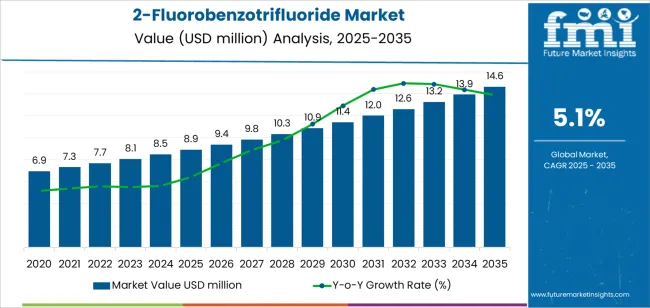
Between 2025 and 2030, the 2-fluorobenzotrifluoride market is projected to expand from USD 8.9 million to USD 11.4 million, resulting in a value increase of USD 2.5 million, which represents 44% of the total forecast growth for the decade. This phase of development will be shaped by increasing pharmaceutical research activities, rising adoption of advanced synthetic methodologies, and growing availability of high-purity chemical intermediates across pharmaceutical manufacturing facilities and specialty chemical production companies.
Between 2030 and 2035, the 2-fluorobenzotrifluoride market is forecast to grow from USD 11.4 million to USD 14.6 million, adding another USD 3.2 million, which constitutes 56% of the overall ten-year expansion. This period is expected to be characterized by the advancement of precision chemistry applications, the development of specialized synthetic pathways for complex pharmaceutical compounds, and the expansion of custom manufacturing services across diverse chemical and pharmaceutical applications. The growing emphasis on advanced drug discovery and precision chemical manufacturing will drive demand for high-purity 2-fluorobenzotrifluoride varieties with enhanced reactivity characteristics, improved stability profiles, and superior analytical specifications.
Between 2020 and 2024, the 2-fluorobenzotrifluoride market experienced steady growth, driven by increasing pharmaceutical research investments and growing recognition of fluorinated intermediates' importance in modern synthetic chemistry applications. The 2-fluorobenzotrifluoride market developed as chemical manufacturers recognized the advantages of specialized fluorinated compounds in creating complex molecular structures and began seeking high-quality intermediates designed specifically for demanding synthetic applications. Technological advancement in fluorination chemistry and purification technologies began emphasizing the critical importance of maintaining chemical purity while enhancing production efficiency and improving cost-effectiveness across diverse pharmaceutical and chemical manufacturing applications.
| Metric | Value |
|---|---|
| Estimated Value in (2025E) | USD 8.9 million |
| Forecast Value in (2035F) | USD 14.6 million |
| Forecast CAGR (2025 to 2035) | 5.1% |
From 2030 to 2035, the 2-fluorobenzotrifluoride market is forecast to grow from USD 11.4 million to USD 14.6 million, adding another USD 3.2 million, which constitutes 56% of the overall ten-year expansion. This period is expected to be characterized by the advancement of computational chemistry integration in synthetic pathway optimization, the integration of artificial intelligence systems for optimal reaction condition prediction, and the development of specialized production facilities for ultra-high purity fluorinated intermediates. The growing emphasis on precision pharmaceutical manufacturing and advanced chemical synthesis will drive demand for premium varieties with enhanced analytical certification capabilities, improved batch-to-batch consistency, and superior quality assurance characteristics.
Between 2020 and 2024, the 2-fluorobenzotrifluoride market experienced robust growth, driven by increasing awareness of fluorinated compound advantages in pharmaceutical synthesis and growing recognition of specialized intermediates' effectiveness in supporting complex chemical transformations across research facilities and manufacturing operations. The 2-fluorobenzotrifluoride market developed as users recognized the potential for high-purity fluorinated intermediates to deliver superior synthetic results while meeting modern requirements for comprehensive quality documentation and reliable performance standards. Technological advancement in fluorination processes and analytical characterization methods began emphasizing the critical importance of maintaining structural integrity while extending shelf life and improving user satisfaction across diverse chemical synthesis applications.
Market expansion is being supported by the increasing global demand for specialized pharmaceutical intermediates and the corresponding shift toward high-performance fluorinated compounds that can provide superior synthetic capabilities while meeting user requirements for comprehensive quality assurance and cost-effective chemical manufacturing solutions. Modern pharmaceutical companies are increasingly focused on incorporating chemical intermediates that can enhance synthetic efficiency while satisfying demands for consistent, precisely characterized building blocks and optimized production cost structures. 2-Fluorobenzotrifluoride's proven ability to deliver targeted synthetic excellence, chemical stability improvement, and diverse application possibilities makes it an essential component for pharmaceutical manufacturers and quality-focused chemical synthesis professionals.
The growing emphasis on precision medicine and advanced pharmaceutical development is driving demand for high-performance fluorinated intermediates that can support distinctive molecular architectures and comprehensive synthetic strategies across drug discovery programs, process development applications, and commercial manufacturing operations. User preference for chemical intermediates that combine functional excellence with analytical reliability is creating opportunities for innovative implementations in both traditional and emerging pharmaceutical synthesis applications. The rising influence of automated synthesis platforms and advanced analytical technologies is also contributing to increased adoption of specialized fluorinated building blocks that can provide authentic performance benefits and reliable synthetic outcomes.
The 2-fluorobenzotrifluoride market is segmented by purity level, application, end-use industry, packaging format, and region. By purity level, the 2-fluorobenzotrifluoride market is divided into purity ≥ 99%, purity 95-99%, and purity < 99%. Based on application, the 2-fluorobenzotrifluoride market is categorized into dyes, pesticides, medicines, pharmaceutical intermediates, and others. By end-use industry, the 2-fluorobenzotrifluoride market includes pharmaceutical, agrochemical, specialty chemicals, research institutions, and others. By packaging format, the 2-fluorobenzotrifluoride market encompasses small containers, bulk packaging, and custom packaging. Regionally, the 2-fluorobenzotrifluoride market is divided into North America, Europe, Asia Pacific, Latin America, Middle East & Africa, and other regions.
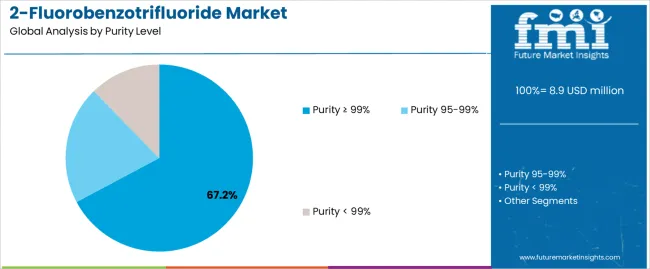
The purity ≥ 99% segment is projected to account for 67.2% of the 2-fluorobenzotrifluoride market in 2025, reaffirming its position as the leading purity category. Pharmaceutical manufacturers and chemical synthesis professionals increasingly utilize high-purity grades for their superior performance characteristics, established quality standards, and essential functionality in diverse synthetic applications across multiple industry sectors. High-purity 2-fluorobenzotrifluoride's proven performance characteristics and established cost-effectiveness directly address user requirements for reliable synthetic results and optimal reaction precision in pharmaceutical and specialty chemical applications.
This purity segment forms the foundation of modern pharmaceutical synthesis patterns, as it represents the quality category with the greatest synthetic reliability potential and established compatibility across multiple chemical manufacturing systems. Industrial investments in advanced purification technology and quality optimization continue to strengthen adoption among pharmaceutical manufacturers. With companies prioritizing synthetic consistency and product reliability, high-purity systems align with both performance objectives and regulatory requirements, making them the central component of comprehensive pharmaceutical manufacturing strategies.
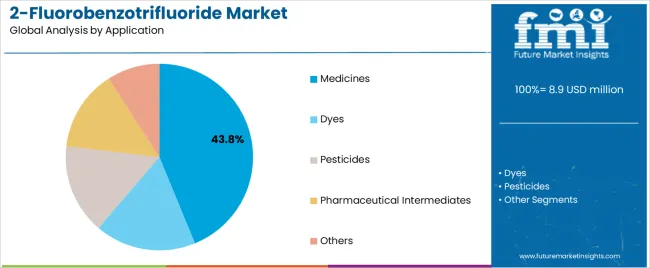
Medicines is projected to represent 43.8% of the 2-fluorobenzotrifluoride market in 2025, underscoring its critical role as the primary application for pharmaceutical companies seeking superior synthetic performance and enhanced drug development capabilities. Pharmaceutical manufacturers and research organizations prefer medicine applications for their established performance requirements, proven market demand, and ability to maintain exceptional synthetic precision while supporting versatile molecular construction during diverse pharmaceutical development activities. Positioned as essential applications for pharmaceutical manufacturers, medicine offerings provide both synthetic excellence and regulatory compliance advantages.
The segment is supported by continuous improvement in pharmaceutical synthesis technology and the widespread availability of established quality standards that enable performance assurance and premium positioning at the industrial level. Additionally, pharmaceutical users are optimizing intermediate selections to support compound-specific applications and comprehensive drug development strategies. As pharmaceutical technology continues to advance and companies seek efficient synthetic methods, medicine applications will continue to drive market growth while supporting drug development and pharmaceutical manufacturing quality strategies.
The 2-fluorobenzotrifluoride market is advancing rapidly due to increasing demand for specialized pharmaceutical intermediates and growing need for high-purity fluorinated compounds that emphasize superior synthetic performance across pharmaceutical segments and specialty chemical applications. The 2-fluorobenzotrifluoride market faces challenges, including competition from alternative fluorinated intermediates, regulatory compliance requirements, and supply chain cost considerations affecting adoption rates. Innovation in synthetic methodology optimization and advanced purification technologies continues to influence market development and expansion patterns.
The growing adoption of 2-fluorobenzotrifluoride in pharmaceutical research and development programs is enabling companies to develop synthetic strategies that provide distinctive molecular building capabilities while commanding enhanced reaction efficiency and superior product quality characteristics. Pharmaceutical applications provide superior synthetic consistency while allowing more sophisticated molecular construction features across various drug discovery categories. Users are increasingly recognizing the synthetic advantages of fluorinated intermediate positioning for comprehensive pharmaceutical outcomes and research-integrated drug development management.
Modern 2-fluorobenzotrifluoride manufacturers are incorporating advanced analytical testing methods, comprehensive quality control protocols, and automated documentation systems to enhance product consistency, improve synthetic reliability, and meet customer demands for detailed quality assurance solutions. These systems improve operational effectiveness while enabling new applications, including continuous quality monitoring programs and predictive quality maintenance protocols. Advanced analytical integration also allows customers to support proactive quality assurance positioning and performance verification beyond traditional chemical intermediate operations.
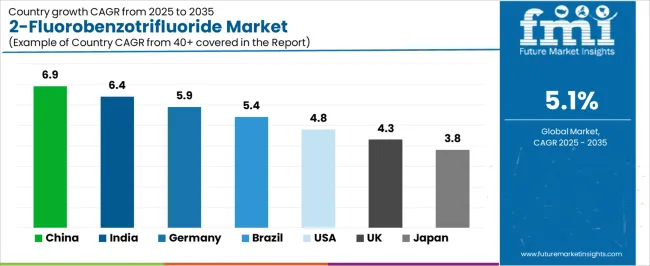
| Country | CAGR (2025-2035) |
|---|---|
| China | 6.9% |
| India | 6.4% |
| Germany | 5.9% |
| Brazil | 5.4% |
| USA | 4.8% |
| UK | 4.3% |
| Japan | 3.8% |
The 2-fluorobenzotrifluoride market is experiencing steady growth globally, with China leading at a 6.9% CAGR through 2035, driven by the expanding pharmaceutical manufacturing sector, growing chemical industry investment, and increasing adoption of advanced fluorinated intermediates. India follows at 6.4%, supported by rising pharmaceutical research activities, expanding chemical manufacturing base, and growing acceptance of specialty chemical technologies. Germany shows growth at 5.9%, emphasizing established pharmaceutical excellence and comprehensive chemical technology development. Brazil records 5.4%, focusing on pharmaceutical industry expansion and specialty chemical consciousness growth. The USA demonstrates 4.8% growth, prioritizing advanced pharmaceutical technologies and chemical manufacturing optimization.
The report covers an in-depth analysis of 40+ countries, the top-performing countries are highlighted below.
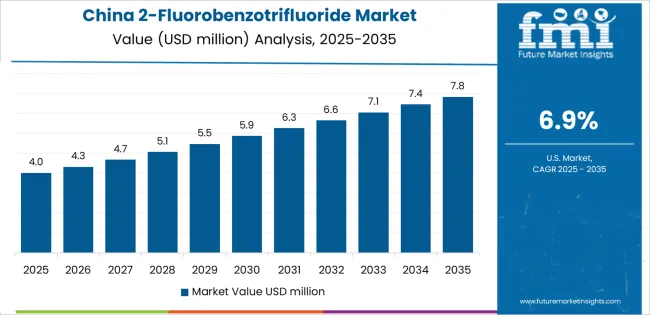
Revenue from 2-fluorobenzotrifluoride consumption and sales in China is projected to exhibit exceptional growth with a CAGR of 6.9% through 2035, driven by the country's rapidly expanding pharmaceutical manufacturing sector, favorable government policies toward chemical industry development, and initiatives promoting advanced synthetic chemistry technologies across major industrial regions. China's position as a leading pharmaceutical manufacturing hub and increasing focus on specialty chemical production systems are creating substantial demand for high-quality 2-fluorobenzotrifluoride in both domestic and export markets. Major pharmaceutical companies and chemical distributors are establishing comprehensive manufacturing capabilities to serve growing demand and emerging pharmaceutical development opportunities.
Revenue from 2-fluorobenzotrifluoride products in India is expanding at a CAGR of 6.4%, supported by rising pharmaceutical industry investment, growing chemical manufacturing consciousness, and expanding distributor capabilities. The country's developing pharmaceutical infrastructure and increasing industrial investment in specialty chemicals are driving demand for 2-fluorobenzotrifluoride across both traditional and modern pharmaceutical applications. International chemical companies and domestic distributors are establishing comprehensive operational networks to address growing market demand for pharmaceutical intermediates and efficient chemical solutions.
Revenue from 2-fluorobenzotrifluoride products in Germany is projected to grow at a CAGR of 5.9% through 2035, supported by the country's mature pharmaceutical standards, established chemical industry regulations, and leadership in chemical technology. Germany's sophisticated pharmaceutical manufacturing standards and strong support for advanced chemical systems are creating steady demand for both traditional and innovative 2-fluorobenzotrifluoride varieties. Leading chemical manufacturers and specialty distributors are establishing comprehensive operational strategies to serve both domestic markets and growing export opportunities.
Revenue from 2-fluorobenzotrifluoride products in Brazil is projected to grow at a CAGR of 5.4% through 2035, driven by the country's emphasis on pharmaceutical industry development, chemical manufacturing growth, and growing chemical distributor capabilities. Brazilian pharmaceutical companies and chemical users consistently seek performance-focused intermediates that enhance synthetic capabilities and support chemical excellence for both traditional and modern pharmaceutical applications. The country's position as a Latin American pharmaceutical market leader continues to drive innovation in specialized chemical intermediate applications and pharmaceutical manufacturing standards.
Revenue from 2-fluorobenzotrifluoride products in the USA is projected to grow at a CAGR of 4.8% through 2035, supported by the country's emphasis on pharmaceutical technology advancement, chemical manufacturing optimization, and advanced automation integration requiring efficient chemical intermediate solutions. American pharmaceutical companies and chemical users prioritize performance reliability and synthetic precision, making specialized 2-fluorobenzotrifluoride essential components for both traditional and modern pharmaceutical synthetic applications. The country's comprehensive pharmaceutical technology leadership and advancing chemical patterns support continued market expansion.
Revenue from 2-fluorobenzotrifluoride products in the UK is projected to grow at a CAGR of 4.3% through 2035, supported by established pharmaceutical standards, mature chemical markets, and emphasis on chemical reliability across pharmaceutical and specialty chemical sectors. British pharmaceutical companies and chemical professionals prioritize quality performance and chemical consistency, creating steady demand for premium chemical intermediate solutions. The country's comprehensive market maturity and established pharmaceutical practices support continued development in specialized applications.
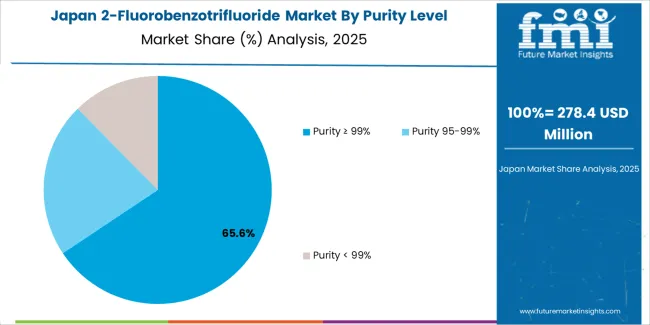
Revenue from 2-fluorobenzotrifluoride products in Japan is projected to grow at a CAGR of 3.8% through 2035, supported by the country's emphasis on precision manufacturing, pharmaceutical excellence, and advanced technology integration requiring efficient chemical intermediate solutions. Japanese pharmaceutical companies and chemical users prioritize technical performance and manufacturing precision, making specialized 2-fluorobenzotrifluoride essential components for both traditional and modern pharmaceutical synthetic applications. The country's comprehensive pharmaceutical leadership and advancing chemical patterns support continued market expansion.
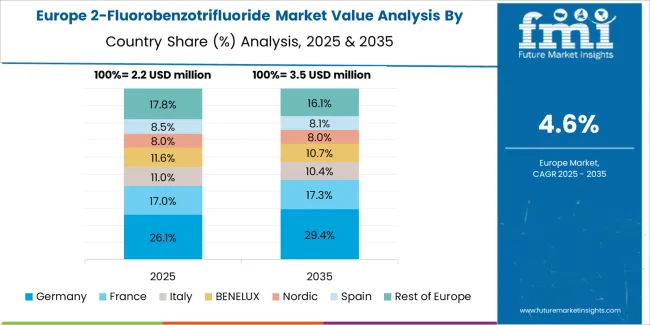
The Europe 2-fluorobenzotrifluoride market is projected to grow from USD 2.1 million in 2025 to USD 3.3 million by 2035, recording a CAGR of 4.7% over the forecast period. Germany leads the region with a 42.8% share in 2025, moderating slightly to 41.9% by 2035, supported by its strong pharmaceutical regulations and demand for premium, technologically advanced chemical intermediates. The United Kingdom follows with 23.7% in 2025, easing to 22.8% by 2035, driven by a mature pharmaceutical market and emphasis on chemical reliability and synthetic performance. France accounts for 14.2% in 2025, rising to 15.1% by 2035, reflecting steady adoption of pharmaceutical technologies and chemical enhancement. Italy holds 8.9% in 2025, expanding to 9.7% by 2035 as pharmaceutical consciousness and specialty chemical applications grow. Spain contributes 5.8% in 2025, growing to 6.2% by 2035, supported by expanding pharmaceutical development and chemical awareness modernization. The Nordic countries rise from 3.1% in 2025 to 3.4% by 2035 on the back of strong pharmaceutical consciousness and advanced chemical methodologies. BENELUX remains at 1.5% share across both 2025 and 2035, reflecting mature, pharmaceutical-focused chemical markets.
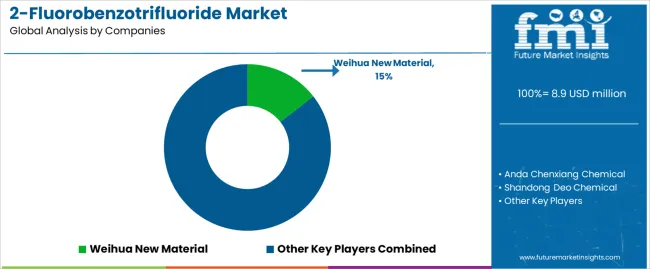
The 2-fluorobenzotrifluoride market is characterized by competition among established chemical manufacturers, specialized fluorinated compound producers, and integrated pharmaceutical technology providers. Companies are investing in advanced synthesis technologies, specialized purification systems, product innovation capabilities, and comprehensive distribution networks to deliver consistent, high-quality, and reliable 2-fluorobenzotrifluoride products. Innovation in synthetic efficiency, purification optimization, and pharmaceutical-focused product development is central to strengthening market position and customer satisfaction.
Weihua New Material leads the 2-fluorobenzotrifluoride market with a strong focus on chemical technology innovation and comprehensive 2-fluorobenzotrifluoride solutions, offering pharmaceutical and industrial grades with emphasis on performance excellence and technological heritage. Anda Chenxiang Chemical provides specialized fluorinated compounds with a focus on Asian market applications and precision manufacturing networks. Shandong Deo Chemical delivers integrated chemical solutions with a focus on industrial positioning and manufacturing efficiency. Jiangsu Yongchuang Pharmaceutical Technology specializes in pharmaceutical-grade intermediates with an emphasis on pharmaceutical applications.
The success of 2-fluorobenzotrifluoride in meeting pharmaceutical demands, chemical manufacturing requirements, and synthetic integration will not only enhance pharmaceutical outcomes but also strengthen global chemical technology manufacturing capabilities. It will consolidate emerging regions' positions as hubs for efficient chemical production and align advanced economies with comprehensive pharmaceutical systems. This calls for a concerted effort by all stakeholders -- governments, industry bodies, manufacturers, distributors, and investors. Each can be a crucial enabler in preparing the 2-fluorobenzotrifluoride market for its next phase of growth.
How Governments Could Spur Local Production and Adoption?
How Industry Bodies Could Support Market Development?
How Distributors and Chemical Industry Players Could Strengthen the Ecosystem?
How Manufacturers Could Navigate the Shift?
| Items | Values |
|---|---|
| Quantitative Units (2025) | USD 8.9 million |
| Purity Level | Purity ≥ 99%, Purity 95-99%, Purity < 99% |
| Application | Dyes, Pesticides, Medicines, Pharmaceutical Intermediates, Others |
| End-Use Industry | Pharmaceutical, Agrochemical, Specialty Chemicals, Research Institutions, Others |
| Packaging Format | Small Containers, Bulk Packaging, Custom Packaging |
| Regions Covered | North America, Europe, Asia Pacific, Latin America, Middle East & Africa, Other Regions |
| Countries Covered | China, India, Germany, Brazil, United States, United Kingdom, Japan, and 40+ countries |
| Key Companies Profiled | Weihua New Material, Anda Chenxiang Chemical, Shandong Deo Chemical, Jiangsu Yongchuang Pharmaceutical Technology, and other leading 2-fluorobenzotrifluoride companies |
| Additional Attributes | Dollar sales by purity level, application, end-use industry, packaging format, and region; regional demand trends, competitive landscape, technological advancements in chemical synthesis engineering, precision manufacturing initiatives, pharmaceutical enhancement programs, and premium product development strategies |
The global 2-fluorobenzotrifluoride market is estimated to be valued at USD 8.9 million in 2025.
The market size for the 2-fluorobenzotrifluoride market is projected to reach USD 14.6 million by 2035.
The 2-fluorobenzotrifluoride market is expected to grow at a 5.1% CAGR between 2025 and 2035.
The key product types in 2-fluorobenzotrifluoride market are purity ≥ 99%, purity 95-99% and purity < 99%.
In terms of application, medicines segment to command 43.8% share in the 2-fluorobenzotrifluoride market in 2025.






Full Research Suite comprises of:
Market outlook & trends analysis
Interviews & case studies
Strategic recommendations
Vendor profiles & capabilities analysis
5-year forecasts
8 regions and 60+ country-level data splits
Market segment data splits
12 months of continuous data updates
DELIVERED AS:
PDF EXCEL ONLINE

Thank you!
You will receive an email from our Business Development Manager. Please be sure to check your SPAM/JUNK folder too.
Chat With
MaRIA